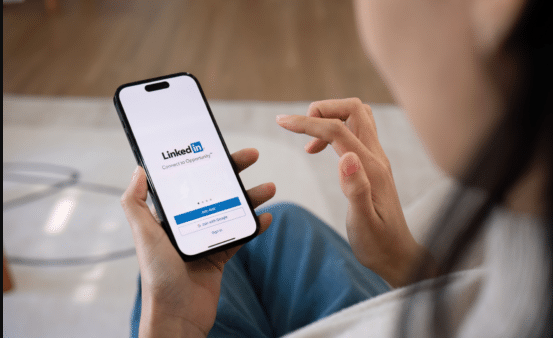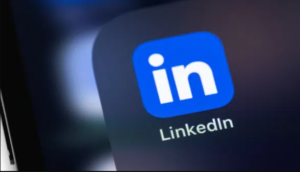Dive into the benefits, setup process and tips for running effective LinkedIn Message Ads that convert your leads into valuable connections.
LinkedIn Message Ads are a powerful tool for B2B marketers looking to directly engage with their target audience.
This guide will walk you through everything you should know about Message Ads, from their basic definition to advanced implementation strategies.
What are LinkedIn Message Ads?
Message ads deliver direct messages to your prospects through LinkedIn Messaging, encouraging action.
These ads are native, meaning they’re designed to blend seamlessly with regular LinkedIn messages. They can appear on both desktop and mobile devices.
Here’s an example of a Message Ad:

Dig deeper: LinkedIn advertising: A comprehensive guide
How can I tell the difference between a Message Ad and a regular message on LinkedIn?
If you go into the Messaging section of LinkedIn, you can see that some messages have the word Sponsored in the preview on the left side. Those are Message Ads.
What’s the difference between Message Ads and Conversation Ads?
Both are forms of sponsored messaging through LinkedIn.
- Message ads consist of a targeted message with a single call-to-action button that drives to a landing page.
- Conversation ads consist of a targeted message with multiple call-to-action buttons that can drive to a landing page, open a lead gen form or provide more information in follow-up messages.
Are there any restrictions on Message Ads that I should be aware of?
Yes. You cannot target LinkedIn members based in the European Union (EU).
If a campaign includes both EU and non-EU targeting, the campaign will deliver to non-EU audiences only.
Why should I use Message Ads?
According to LinkedIn, they drive higher engagement and response rates compared to traditional email marketing.
While Mailchimp’s industry average open rate is 21%, LinkedIn reports an average of 50%.
In my experience running multiple Message Ads for an enterprise-level financial services client, I’ve seen an impressive average open rate of 56.69%, closely aligning with LinkedIn’s benchmarks
Which objectives can I use when running Message Ads?
You can only create Message Ads using website visits, lead generation or website conversion objectives. I most often use the Website Visits objective when creating Message Ads.
How to set up a LinkedIn Message Ad
To get started, you only need a few things:
- A sender: There is a process for this that I’ll talk about in the next section.
- Subject line: 60 characters maximum.
- Message text: 1,500 characters maximum.
- Call to action (CTA): Up to 20 characters.
- Image (Optional): 300x250px banner image.
- Custom footer (Optional): This can be a disclaimer or terms and conditions.
- Lead form (Optional): If you selected lead generation as the campaign objective, you’ll need to attach a form to your ad.
Best practices when developing Message Ads
Following best practices is essential for driving engagement and conversions with your LinkedIn Message Ads.
Identify a reputable sender
Ensure the recipient is already a first-degree connection on LinkedIn. You’ll need to send them a request through the platform, which they must approve.
To do this, click the Add a sender button when creating your ad, type in their name, select them and then hit Send request.

Keep your subject line concise, relevant and conversational
LinkedIn recommends using keywords such as:
- “Exclusive invitation”
- “Connect”
- “Opportunities”
- “Join us/me”
I’ve personally seen great success using “Join me” in subject lines.
Make sure the sender introduces themselves
This should be done at the start of the message. Communicate a clear purpose that speaks to your audience. Capture their attention and tell them quickly why they should keep reading.
Customize your message by adding custom fields
If you add %FIRSTNAME%, %LASTNAME%, %COMPANYNAME%, %JOBTITLE%, and/or %INDUSTRY%, these macros will dynamically insert the recipient’s first name, last name, company name, job title and/or industry.
If the user has more than one current company or job title, then LinkedIn will populate the recipient’s most recently added company or job title.

Keep your message text below 500 characters
While you can have up to 1,500 characters maximum, try to keep it brief.
Test hyperlinks
While LinkedIn suggests that adding a hyperlink in your message can boost click performance, my experience shows no noticeable impact – though it’s still worth testing.
Always test your message before you go live
Once you’ve created the ad, hit save. Before you review and launch your ad, hit the three dots next to your message ad. You’ll see an option to “Send test message.”
This will be sent directly to your LinkedIn messages. You can see how the message renders, including any custom fields.
Testing is also extra important because once you change your ad status from Draft to Active, the ad can no longer be edited.
What metrics should I look at to evaluate Message Ad performance?
This depends on which objective you use:
Website visits objective
- Sends: Number of times your ad was sent (i.e., impressions).
- Opens: Number of times your ad was opened (unique opens).
- Open rate: The percentage of messages opened compared to the total sent.
- Website visits: Number of times someone clicked through your ad to your landing page.
- Cost per action (website visit): Total cost divided by the number of website visits.
- Click-through rate: Number of clicks divided by total impressions.
Website conversions objective
- Sends: Number of times your ad was sent (i.e., impressions).
- Opens: Number of times your ad was opened (unique opens).
- Open rate: The percentage of messages opened compared to the total sent.
- Conversions: Total number of times member accounts took a desired action after clicking on or seeing your ad.
- Cost per action (website conversions): Total cost divided by the number of website conversions.
- Conversion rate: Number of conversions divided by total clicks.
Lead generation objective
- Sends: Number of times your ad was sent (i.e., impressions)
- Opens: Number of times your ad was opened (unique opens)
- Open rate: The percentage of messages opened compared to the total sent.
- Leads: Number of users who have submitted their information through your lead form ad
- Cost per lead: Total cost divided by the number of leads.
- Lead form completion rate: Number of lead form submissions divided by the number of lead form opens.
Maximize your LinkedIn advertising with Message Ads
LinkedIn Message Ads offer a powerful way to directly engage with your target audience on a professional platform.
By understanding the key components, best practices and performance metrics we’ve discussed, you can create compelling campaigns that resonate with your prospects.
Remember to always test your messages, choose your sender wisely and continuously monitor your performance metrics to optimize your campaigns.
With the right strategy, Message Ads can become a valuable tool in your B2B marketing arsenal, helping you build relationships, generate leads and drive conversions.




